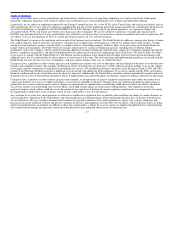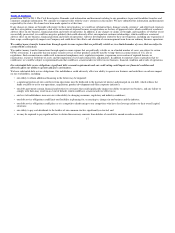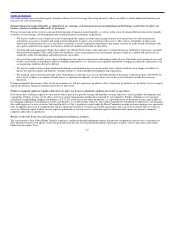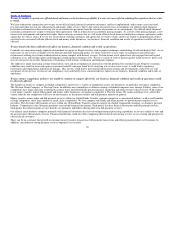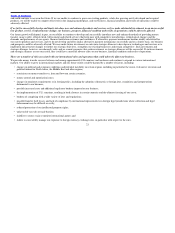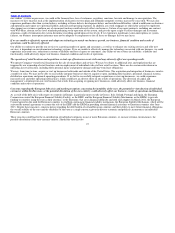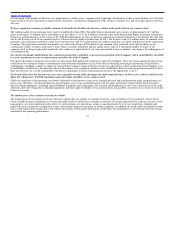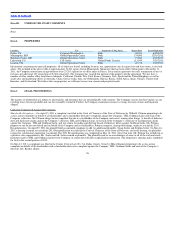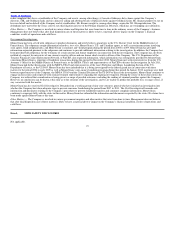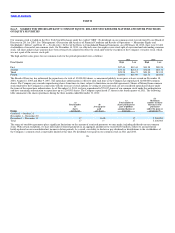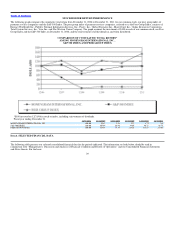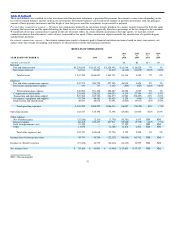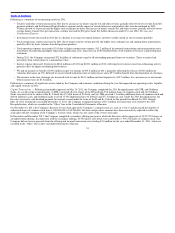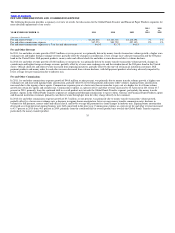MoneyGram 2011 Annual Report Download - page 26
Download and view the complete annual report
Please find page 26 of the 2011 MoneyGram annual report below. You can navigate through the pages in the report by either clicking on the pages listed below, or by using the keyword search tool below to find specific information within the annual report.
Table of Contents
of votes equal to the number of directors as is proportionate to the Investors’ common stock ownership, calculated on a fully−converted basis, as if all of the
shares of D Stock were converted to common shares. Therefore, each director designated by THL will have multiple votes and each other director will have
one vote.
We have significant overhang of salable common stock and D Stock held by the Investors relative to the public float of our common stock.
The trading market for our common stock was first established in June 2004. The public float in that market now consists of approximately 62.3 million
shares issued and 57.8 million shares outstanding as of December 31, 2011. In accordance with the terms of the Registration Rights Agreement entered into
between us and the Investors at the closing of the 2008 Recapitalization, we have an effective registration statement on Form S−3 that permits the offer and
sale by the Investors of all of the common stock or D Stock currently held by the Investors. In 2011, the Investors sold 10.2 million shares of common stock
pursuant to this registration statement, which leaves the Investors with 50.7 million shares of common stock that can still be sold pursuant to the registration
statement. The registration statement also permits us to offer and sell up to $500 million of our common stock, preferred stock, debt securities or any
combination of these securities, from time to time, subject to market conditions and our capital needs. Sales of a substantial number of shares of our
common stock, or the perception that significant sales could occur (particularly if sales are concentrated in time or amount), may depress the trading price of
our common stock.
Our charter documents and Delaware law contain provisions that could delay or prevent an acquisition of the Company, which could inhibit your ability
to receive a premium on your investment from a possible sale of the Company.
Our charter documents contain provisions that may discourage third parties from seeking to acquire the Company. These provisions and specific provisions
of Delaware law relating to business combinations with interested stockholders may have the effect of delaying, deterring or preventing certain business
combinations, including a merger or change in control of the Company. Some of these provisions may discourage a future acquisition of the Company even
if stockholders would receive an attractive value for their shares or if a significant number of our stockholders believed such a proposed transaction to be in
their best interests. As a result, stockholders who desire to participate in such a transaction may not have the opportunity to do so.
Our board of directors has the power to issue series of preferred stock and to designate the rights and preferences of those series, which could adversely
affect the voting power, dividend, liquidation and other rights of holders of our common stock.
Under our certificate of incorporation, our board of directors has the power to issue series of preferred stock and to designate the rights and preferences of
those series. Therefore, our board of directors may designate a new series of preferred stock with the rights, preferences and privileges that the board of
directors deems appropriate, including special dividend, liquidation and voting rights. The creation and designation of a new series of preferred stock could
adversely affect the voting power, dividend, liquidation and other rights of holders of our common stock and, possibly, any other class or series of stock that
is then in existence.
The market price of our common stock may be volatile.
The market price of our common stock may fluctuate significantly in response to a number of factors, some of which may be beyond our control. These
factors include the perceived prospects or actual operating results of our business; changes in estimates of our operating results by analysts, investors or our
management; our actual operating results relative to such estimates or expectations; actions or announcements by us or our competitors; litigation and
judicial decisions; legislative or regulatory actions; and changes in general economic or market conditions. In addition, the stock market in general has from
time to time experienced extreme price and volume fluctuations. These market fluctuations could reduce the market price of our common stock for reasons
unrelated to our operating performance.
25


